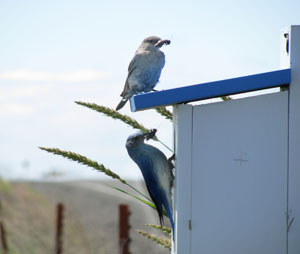In “real life” (when I’m not volunteering), I work on environmental stewardship planning and audits. This often involves travel. Flying is seldom fun. On my last flight, Northwest Airlines apparently fed my luggage to a large, angry dragon. My bags are now in a shredded state suitable for composting.
 |
A Western Bluebird couple delivers an insect breakfast to their brood. Photo by Bet Zimmerman. |
Occasionally there is an upside to travel. In between audits in eastern Washington State, I had a spare Saturday. I decided to take a ride out to Bickleton. Bickleton is not quite as big as Woodstock CT. If you go to their website, you can see photos of Dick & Delma’s 50th anniversary party. With a population of 113, Bickleton has way more birds than people. In fact, it has a LOT of birds – bluebirds that is. They are not thriving there by accident.
Mountain and Western Bluebirds flock to Bickleton because of the Brinkerhoff family. 1968, Jess and Elva Brinkerhoff took a day trip to this tiny town. They wanted to show their two young sons the spring profusion of wildflowers. While enjoying the scenery, they spotted a bluebird. Hoping to encourage it to stay, they retrieved a metal coffee can from the local dump, fashioned a rough birdhouse and nailed it to a tree. As they stood by and watched, two bluebirds moved in.
The Brinkerhoffs were hooked. Over the next four decades, they and others installed an estimated 2,000 wooden bluebird houses in and around the town. Each year, a Bickleton “bluebird brigade” of residents, farmers, and school children volunteer to build, repair, paint and clean out the boxes. Some funding for their efforts comes from souvenir sales at the Whoop-n-Holler Museum. I hope to visit it on my next trip west. Small town museums are typically chocked with interesting treasures and local lore.
Bickleton looks a bit like Woodstock, with miles of rolling hills and meadows. Over time, expanding farm fields and a local sawmill claimed most of the trees previously used by cavity nesters like bluebirds. One former resident noted that “You didn’t see many bluebirds after that.” Without nestboxes, bluebirds would have eventually disappeared, as they do not nest out in the open.
Instead, they are everywhere. Almost every box I saw was being used by nesting bluebirds. Unfortunately, I also saw several House Sparrows nesting near residences or farms. If Bickleton were more residential, or if too many people fed birdseed with millet or cracked corn, House Sparrows would probably take over their bluebird trail.
Because there are so few trees, most of the bluebird boxes in Bickleton are mounted on fence posts. With that many boxes, it would be prohibitively expensive to mount nestboxes on predator-proof EMT conduit equipped with wobbling baffles. In CT, boxes mounted on wooden posts or trees often provide a “Happy Meal” to raccoons or snakes.
Many of the Bickleton boxes are painted white to reflect the summer heat, and sport blue roofs that may attract occupants. Some were in disrepair, but most were in excellent condition. Some were made in a style not suited for weekly monitoring of nesting activity. For example, they open from the bottom. Imagine what would happen if you opened the box to check how many eggs were inside. None of the boxes I saw were paired. In some areas where Tree Swallows are common, two boxes are placed 5-15 feet apart, allowing Tree Swallows to take one, and bluebirds the other. If they are spaced more than 20-25 feet apart, Tree Swallows often use both.
In 1983, the Brinkerhoffs were honored with the John and Nora Lane award by the North American Bluebird Society for outstanding contributions to bluebird conservation. Elva Brinkerhoff passed away in 1985, but her legacy lives on. The town claims to be the "bluebird capital of the world." Maybe someday, with your help, the Quiet Corner could be the bluebird capital of Connecticut. |

